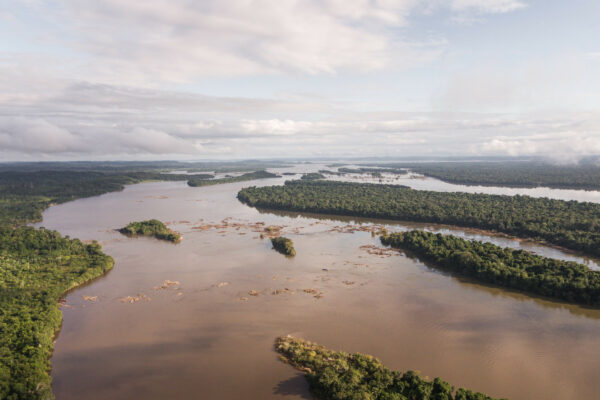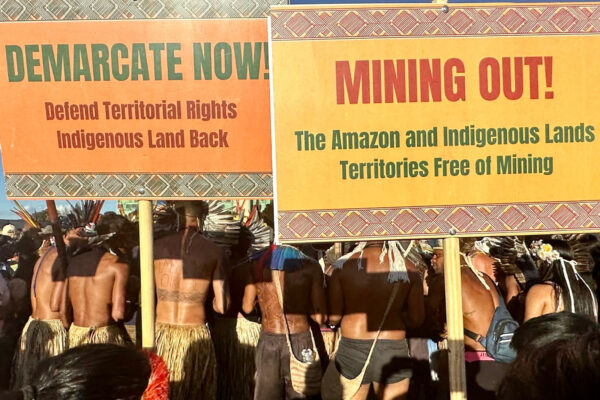Paracas, Peru – In the barren moonlike landscape outside this coastal hamlet, workers in hard hats are busily laying cables and constructing giant holding tanks for natural gas liquids. An alliance that includes
well-known names in energy like Hunt Oil of Texas and Pluspetrol of Argentina then plans to lay two miles of pipe along the ocean floor to a loading platform for tankers.
The development in Paracas, about three hours’ drive south from Lima, is part of an ambitious project, which could cost up to $3.6 billion, to export butane, propane and, eventually, natural gas to California.
Peruvian officials say the development, 20 years in the making, would be a crucial engine for growth as the country, which is resource rich but cash poor, tries to transform itself into an energy exporter.
But a surging environmental movement – led by activists from the United States – is pushing hard to halt construction at this plant, which is still in its early stages, and force it to move elsewhere.
Asserting that the plant is a danger to the country’s only marine reserve, a sanctuary for sea turtles, rare penguins and sea lions only 4.3 miles to the south, environmental groups won a big victory on Aug. 28. That was when the Export-Import Bank, a credit agency of the United States government, rejected a $214 million loan, citing concerns about the environment.
Now, the Inter-American Development Bank is set to vote on Sept. 10 on $75 million in additional financing that, if rejected, could place at least another $60 million in syndicated loans in jeopardy.
Peruvian government officials and operators of the Camisea project – named for the region where the wells are – said they had lined up $225 million in optional financing from a Peruvian bank and promised to finish the project.
[On Monday, the Andean Development Corporation approved long-term loans worth $75 million, Peru’s government said.]But an adverse decision could be a serious blow to the project’s image and set a precedent sought by environmentalists – that multinational lending agencies, particularly those dependent on American money, ensure
rigorous environmental standards before providing big loans.
“Camisea is a key test for the international financial institutions and the United States government,” said Senator Patrick Leahy of Vermont, the ranking Democrat in the foreign operations subcommittee of the Appropriations Committee and a leading critic of the project. “The issue
is whether the Inter-American Development Bank, financed with U.S. taxpayer dollars, will protect a pristine area.”
Alliance engineers and officials in President Alejandro Toledo’s government, which says the project would increase gross domestic product 0.8 percent a year, assert that the highest environmental standards have been exceeded. They accuse environmental groups of exaggerating deficiencies in a quest to terminate the project.
“We had 18 public meetings,” said Jaime Quijandría, the economy minister. “Problems came up, but not the kinds of problems that are being raised now.”
Mr. Quijandría added: “We are certain there is not going to be any environmental damage.”
Project officials and government officials admit errors in the development, but say that standards were improved as environmentalists and consulting firms hired by the multinational lenders raised concerns.
Alejandro Segret, general manager of TGP in Peru, noted that the pipeline construction, which his company is leading, will be underground, to be covered by jungle.
“Our focus was always to minimize the environmental and social damage,” he said. “This is one of the most transparent projects there has been in this country.”
But environmental groups like Amazon Watch, Conservation International and the World Wildlife Fund and a collection of grass-roots groups have warned of environmental devastation. And some of their concerns have been echoed by some officials at the Export-Import Bank, the Inter-American Development Bank and by some members of Congress.
The Camisea fields, discovered a generation ago by Shell, were envisioned as one of the largest energy developments in Latin America.
Shell eventually dropped out, and the project has been developed by companies like Hunt Oil of Texas; Pluspetrol of Argentina; Techint, which owns TGP; the SK Corporation of South Korea; Sonatrach, an Algerian state-owned company, and Tractebel, the Belgian energy giant.
The companies are developing gas fields thought to hold 13 trillion cubic feet of natural gas and condensate, including butane and propane, an enormous amount. Wells are being developed in the lower Urubamba region of the Peruvian Amazon, along with a gas- and-liquids separation
plant and two pipelines stretching across the Andes.
One pipeline, 445 miles long, is projected to transport gas to Lima by August, lowering electricity rates and improving air quality. The other, 335 miles long, leads to this 600-acre site. All this will cost $1.6 billion.
Another $2 billion will be spent to build a plant to liquefy the natural gas and, by 2007, become a major supplier to the United States. A leading candidate for the job would be Halliburton, another Texas company, a Hunt Oil official said.
Both companies have close ties to the Bush administration (Vice President Dick Cheney was chief executive of Halliburton). The administration’s energy policy calls for diversifying the sources of America’s energy imports and reducing dependence on the Middle East.
But the project cuts through some of the world’s most pristine jungles, home not only to rare species of birds and animals but also to indigenous tribes. Wells are being developed in the Nahua Kugapakori Indigenous Reserve, a region established to protect three tribes living in virtual isolation from modern Peru.
“These populations depend exclusively on the territory where they live, the river, the woods,” said Beatriz Huertas, adviser to a tropical forest Indian organization. “But the new contacts cause sickness,
transmission of disease and death.”
Environmentalists also say that the project has led to serious soil erosion, the contamination of rivers and the killing of fish and that developers have cut through communities without providing adequate reimbursement.
Reports from the United States Agency for International Development and an environmental assessment memo from the Export-Import Bank show that the United States has had deep concerns about a lack of transparency, about environmental studies that are called shoddy or insufficient and a lack of knowledge of native groups in the region.
An environmental assessment by the Export-Import Bank says access roads and other paths cut into the jungle “have produced significant direct negative impacts.” The report also says “deforestation, human population growth and consequent losses of biodiversity” are “by far the most
significant potential negative effects.”
Regarding the Paracas site, the Export-Import Bank report says that while oceanographic conditions were taken into account in choosing the site, no adequate assessments of the social or environmental impacts were conducted on five other alternative sites, contradicting government
officials and project officials.
A July memo from the United States Agency for International Development recommended that the Treasury Department, which determines the vote at the Inter-American Development Bank, withhold support for the loan.
Environmentalists concede that much of the work on the Camisea project is complete. Indeed, Norberto Benito, general manager of Pluspetrol in Peru, said the well sites, the pipeline and the gas-and-liquids separation plant are largely done, with about $1.2 billion already
spent.
The hope now, environmentalists say, is to halt work on this project in Paracas, at a fractionation plant that would separate gas liquids and pipe them into a marine terminal. About 20 percent of the work is done, engineers here said during a tour.
“We’re saying, ‘You didn’t go through the necessary requirements to make a sound decision on whether it should be in Paracas or not,’ ” said Greg Love, who closely follows the Camisea project for Conservation International. “Our position has always been to do it over.”
Government officials and the project’s sponsors say halting construction is unthinkable. Closing down here and moving to another site would cost an estimated $100 million.
“No way,” said Roberto Dañino, the Peruvian ambassador in Washington, who has lobbied hard for the project.
Mr. Dañino says the plant is exactly where it needs to be, in a region with a natural harbor and slight embankment that makes the plant safe from tidal waves.
On first glance, the site does not look like much. The coastline around here is already polluted, thanks to a string of fish meal plants that spew waste into the ocean. And the bone-dry, dusty land around the plant is covered with mounds of empty shells of marine life discarded by the
plants.
But just to the south is the hamlet of Paracas, with its hotels, seafood restaurants and a fishing fleet that is dependent on fishing grounds loaded with mackerel, anchovies and other fish. And nearby is the Paracas reserve, a 135,000-acre land-and-sea sanctuary popular with
Peruvians and foreigners.
“Paracas is a big tourist destination and visitors could stop coming,” said Adalberto Campos, owner of a small hotel. “We wonder what dangers it could bring. We know nothing about the level of pollution we could have.”













